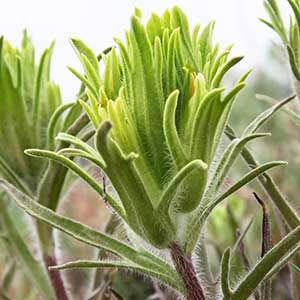Castilleja rupicola
Castilleja oresbia
cliff Indian paintbrush, cliff paintbrush
pale paintbrush, pale Wallowa Indian paintbrush, pale Wallowa paintbrush
many, decumbent to ascending, unbranched, sparsely pubescent, hairs spreading, wavy, fairly short, soft, eglandular, sometimes glabrous proximally.
few to several, erect or ascending, sometimes decumbent at base, unbranched or branched, hairs usually retrorse, medium length, ± soft, eglandular, mixed with very short-glandular ones, sometimes with spreading, long, soft ones.
purple to green, narrowly, rarely broadly, lanceolate, 1.4–4 cm, not fleshy, margins plane, flat to involute, (0–)3–5(–7)-lobed, apex acute to acuminate;
lobes divergent, spreading-ascending, linear, long, not much narrower than mid blade, often with secondary lobes, creating little frilly fans, apex acute or obtuse.
green to purple, linear to lanceolate, 2–7 cm, not fleshy, margins plane, involute, 3–5(–7)-lobed, apex acuminate to acute;
lobes spreading, linear to sometimes narrowly lanceolate, apex acute.
2–6 × 2–3.5 cm;
bracts proximally greenish or deep purple near base, distally red, scarlet, or crimson to red-orange, rarely orange, salmon, pink, or yellowish white, ovate to orbicular in outline, 5(–9)-lobed;
lobes spreading, linear to linear-lanceolate, long, arising below mid length, apex acute to rounded.
2.5–18 × 1–3.5 cm;
bracts pale green to yellow-green or pale, dull reddish brown throughout, or proximally so colored but changing gradually to cream or yellowish on distal margins, narrowly to broadly lanceolate, (3–)5–7(–9)-lobed;
lobes ascending, linear, long, proximal lobes arising below mid length, central lobe apex obtuse, others acute.
straight or slightly curved, 25–35(–45) mm;
tube 9–15 mm;
beak exserted, adaxially green, purplish, or yellow-green, 14–22 mm;
abaxial lip deep green, reduced, 0.5–2 mm, 6–12% as long as beak;
teeth incurved to erect, green, 0.5 mm.
straight, 21–36 mm;
tube 16–20 mm;
teeth of abaxial lip often exserted, beak exserted;
beak adaxially green, 4.2–5.5 mm;
abaxial lip green to purple, distally white, conspicuous, slightly but noticeably pouched, often visible through front cleft, 3–5 mm, 67–100% as long as beak, puberulent;
teeth erect, white, 1.8–2.1 mm.
proximally purple, green, or whitish, distally colored as bract lobes, 15–25 mm;
abaxial and adaxial clefts 8 mm, ca. 40–50% of calyx length, deeper than laterals, lateral 1–5 mm, 10–20% of calyx length;
lobes triangular, apex obtuse or acute.
colored as bracts, 10–25 mm;
abaxial and adaxial clefts 6–7 mm, 30–60% of calyx length, deeper than laterals, lateral 5–10 mm, 40–50% of calyx length;
lobes linear, apex acute.
Castilleja rupicola
Castilleja oresbia
Castilleja rupicola is usually found in the subalpine and lower alpine zones in the Cascade Range from extreme southern British Columbia south to northern Douglas County, Oregon. Though it can be numerous where it occurs, the species as a whole is uncommon. One atypical population occurs in a moist, shaded, mossy, north-facing ravine on the Oregon side of the Columbia River Gorge, at less than 250 m. These plants often bear secondary divisions on deeply dissected leaves and bracts.
(Discussion copyrighted by Flora of North America; reprinted with permission.)
Castilleja oresbia is endemic to eastern Oregon and adjacent Idaho. It is easily confused with both varieties of C. pallescens, which also occur in sagebrush habitats. Castilleja oresbia has longer calyx lobes and softer pubescence than C. pallescens var. pallescens, although some transitional specimens are found. Castilleja oresbia has a combination of longer calyx lobes, longer pubescence, and obscurely nerved bracts, which usually serve to separate it from C. pallescens var. inverta. All three have different, though somewhat overlapping, ranges. Castilleja oresbia occasionally hybridizes with C. peckiana in Grant County, Oregon.
(Discussion copyrighted by Flora of North America; reprinted with permission.)



